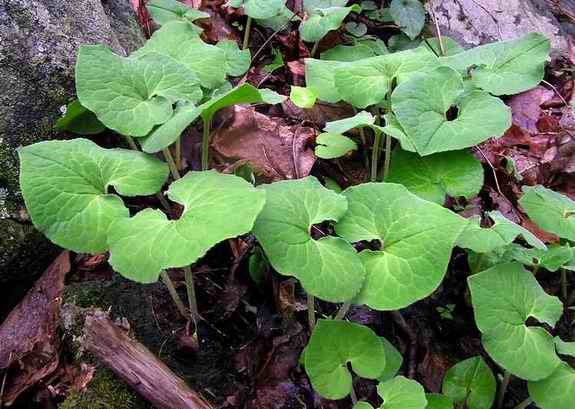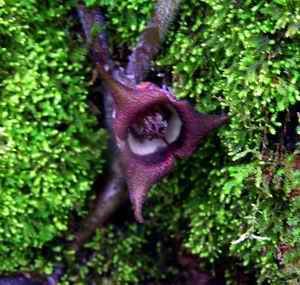|
Return to Hiker's Notebook Home Page
Common Name: Wild Ginger, Heartleaf, Indian ginger, Colicroot, Heart snakeroot, Vermont snakeroot, False coltsfoot, Canada snakeroot, Asarabacca, Little Brown Jugs - The roots have an aroma and flavor that is similar to that of the ginger spice derived from the tropical plant Zingiber officinale (officina means workshop in Latin, referring in this case to something like drugstore; Zingiber is Latin for ginger)..
Scientific Name: Asarum canadense - The generic name is from the Greek asaron meaning hazelwort, the common name of the European species of "wild ginger" (Asarum europaeum). The species name is a Latinized version of Canada, where it was first noted.
Wild Ginger is a member of the Birthwort Family (Aristolochiaceae), which consists of 6 genera and 400 species generally characterized by heart shaped leaves and often with relatively large, carrion-scented flowers that are radially symmetrical. The common name of the family is a derivation of the Latin name, which is taken from the Greek aristo meaning "best" and locheia meaning "childbirth." Birthwort employs the Old English suffix "wort" for any plant that had herbal properties.
European Wild Ginger was highly regarded by the Egyptians, Greeks and Romans for its medicinal qualities, especially for the application for which the name birthwort was applied; it was employed to assist a woman in the postpartum discharge of the placenta. Many members of the Birthwort Family, including the Wild Gingers, contain the compound aristolochic acid, to which pharmaceutical properties are attributed. A. europaeum was cultivated in Europe as an ingredient in a variety of purgatives, as a headache remedy, as a treatment for deafness, and as a palliative for a queasy stomach. It was considered somewhat a panacea, taken in small doses every day to promote general health. To this end, it was one of the ingredients in some types of snuff. It was purportedly used in France as an emetic to induce vomiting after the consumption of an excessive amount of alcohol. The common name Asarabacca reflects the general herbal nature of the plant, 'Asara' for Asarum and 'bacca' for bacara, an aromatic potherb commonly called clary.
As opposed to the more analgesic applications of its European cousin, A. canadense was consumed by North American inhabitants as a food additive due to its pleasant, aromatic taste that has been likened to mild pepper and ginger mixed. Early colonists ground the leaves and roots and dried them to produce a powder that was used as a general spice for otherwise bland foods. It is probable that they adopted this practice from Native Americans, who added powdered ginger root to meals made with meat or fish to prevent ptomaine poisoning due to spoilage. There is some evidence that this practice extended to a belief that it could ward off "evil spirits" in general, ginger being added to the food to prevent its necromantic contamination. Ground up ginger root was also added to an Ojibwe dish made from bottom-feeding catfish to offset the taste of mud. The settlers of the Southern Appalachians made candied ginger by boiling the roots and then dipping them in syrup. It was also used as a scent for clothing to cloak the more pungent, earthy smells that lack of frequent washing would cause to prevail.
A. canadense has a single, three-lobed, dark red flower that grows at the base of the leaves with a very short stem, seemingly clandestine in its obscurity (right). The evolutionary benefits of this arrangement are manifest in the pollinators that provide for fertilization, beetles and other denizens of the leaf litter in which it grows. The plant propagates in part by means of horizontal underground stems called rhizomes, forming colonies that spread rapidly to cover the ground over large areas. The common name Little Brown Jugs calls to mind the unusual basal flowers.
The autochthonous Native Americans and subsequent colonial settlers also used Wild Ginger in a variety of medicinal applications. Of primary import was its use in applications associated with feminine gender conditions, including reproduction. Powdered root was extracted for use by women in the treatment of pain associated with the monthly menstrual cycle; as an emmenagogue to increase the menstrual flow and to relieve swollen breasts. It was also thought to have a deleterious effect on fertilization and was consequently used in small doses as a contraceptive tea and in larger doses to induce an abortion. A second major use of A. Canadense was in the treatment of snakebite. The common names Heart snakeroot, Canadian snakeroot and Vermont snakeroot all attest to this application. The common name Colicroot is due to the use of the plant in the treatment of cramps and other intestinal disorders, primarily in children. The name False coltsfoot is apt, as Coltsfoot is another plant with many medical uses. |

